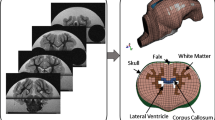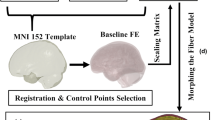Abstract
A systematic correlation between finite element models (FEMs) and histopathology is needed to define deformation thresholds associated with traumatic brain injury (TBI). In this study, a FEM of a transected piglet brain was used to reverse engineer the range of optimal shear moduli for infant (5 days old, 553–658 Pa) and 4-week-old toddler piglet brain (692–811 Pa) from comparisons with measured in situ tissue strains. The more mature brain modulus was found to have significant strain and strain rate dependencies not observed with the infant brain. Age-appropriate FEMs were then used to simulate experimental TBI in infant (\(n=36\)) and preadolescent (\(n=17\)) piglets undergoing a range of rotational head loads. The experimental animals were evaluated for the presence of clinically significant traumatic axonal injury (TAI), which was then correlated with FEM-calculated measures of overall and white matter tract-oriented tissue deformations, and used to identify the metric with the highest sensitivity and specificity for detecting TAI. The best predictors of TAI were the tract-oriented strain (6–7 %), strain rate (38–40 s\(^{-1})\), and strain times strain rate (1.3–1.8 s\(^{-1})\) values exceeded by 90 % of the brain. These tract-oriented strain and strain rate thresholds for TAI were comparable to those found in isolated axonal stretch studies. Furthermore, we proposed that the higher degree of agreement between tissue distortion aligned with white matter tracts and TAI may be the underlying mechanism responsible for more severe TAI after horizontal and sagittal head rotations in our porcine model of nonimpact TAI than coronal plane rotations.











Similar content being viewed by others
References
Anderson AE, Ellis BJ, Weiss JA (2007) Verification, validation and sensitivity studies in computational biomechanics. Comput Methods Biomech Biomed Eng 10:171–184. doi:10.1080/10255840601160484
Bain AC, Meaney DF (2000) Tissue-level thresholds for axonal damage in an experimental model of central nervous system white matter injury. J Biomech Eng 122:615–622
Broglio SP, Schnebel B, Sosnoff JJ, Shin S, Fend X, He X, Zimmerman J (2010) Biomechanical properties of concussions in high school football. Med Sci Sports Exerc 42:2064–2071. doi:10.1249/MSS.0b013e3181dd9156
Cater HL, Sundstrom LE, Morrison B 3rd (2006) Temporal development of hippocampal cell death is dependent on tissue strain but not strain rate. J Biomech 39:2810–2818. doi:10.1016/j.jbiomech.2005.09.023
Chatelin S, Constantinesco A, Willinger R (2010) Fifty years of brain tissue mechanical testing: from in vitro to in vivo investigations. Biorheology 47:255–276. doi:10.3233/BIR-2010-0576
Chatelin S, Deck C, Renard F, Kremer S, Heinrich C, Armspach JP, Willinger R (2011) Computation of axonal elongation in head trauma finite element simulation. J Mech Behav Biomed Mater 4:1905–1919. doi:10.1016/j.jmbbm.2011.06.007
Chatelin S, Vappou J, Roth S, Raul JS, Willinger R (2012) Towards child versus adult brain mechanical properties. J Mech Behav Biomed Mater 6:166–173. doi:10.1016/j.jmbbm.2011.09.013
Cloots RJ, van Dommelen JA, Geers MG (2012) A tissue-level anisotropic criterion for brain injury based on microstructural axonal deformation. J Mech Behav Biomed Mater 5:41–52. doi:10.1016/j.jmbbm.2011.09.012
Cloots RJ, van Dommelen JA, Kleiven S, Geers MG (2013) Multi-scale mechanics of traumatic brain injury: predicting axonal strains from head loads. Biomech Model Mechanobiol 12:137–150. doi:10.1007/s10237-012-0387-6
Coats B, Eucker SA, Sullivan S, Margulies SS (2012) Finite element model predictions of intracranial hemorrhage from non-impact, rapid head rotations in the piglet International journal of developmental neuroscience : the official journal of the International Society for. Dev Neurosci 30:191–200. doi:10.1016/j.ijdevneu.2011.12.009
Colgan NC, Gilchrist MD, Curran KM (2010) Applying DTI white matter orientations to finite element head models to examine diffuse TBI under high rotational accelerations. Prog Biophys Mol Biol 103:304–309. doi:10.1016/j.pbiomolbio.2010.09.008
Cullen DK, LaPlaca MC (2006) Neuronal response to high rate shear deformation depends on heterogeneity of the local strain field. J Neurotrauma 23:1304–1319. doi:10.1089/neu.2006.23.1304
Deck CW, Willinger R (2008) Improved head injury criteria based on head FE model. Int J Crashworthiness 13:667–678
Dickerson JW, Dobbing J (1967) Prenatal and postnatal growth and development of the central nervous system of the pig. Proc R Soc Lond B Biol Sci 166:384–395
Duhaime AC, Hunter JV, Grate LL, Kim A, Golden J, Demidenko E, Harris C (2003) Magnetic resonance imaging studies of age-dependent responses to scaled focal brain injury in the piglet. J Neurosurg 99:542–548. doi:10.3171/jns.2003.99.3.0542
Eucker SA (2009) Effect of head rotation direction on closed head injury in neonatal piglets. PhD Dissertation, University of Pennsylvania
Eucker SA, Smith C, Ralston J, Friess SH, Margulies SS (2011) Physiological and histopathological responses following closed rotational head injury depend on direction of head motion. Exp Neurol 227:79–88. doi:10.1016/j.expneurol.2010.09.015
Fung YC (1994) A first course in continuum mechanics : for physical and biological engineers and scientists, 3rd edn. Prentice Hall, Englewood Cliffs, NJ
Gennarelli TA, Thibault LE, Adams JH, Graham DI, Thompson CJ, Marcincin RP (1982) Diffuse axonal injury and traumatic coma in the primate. Ann Neurol 12:564–574. doi:10.1002/ana.410120611
Giordano C, Cloots RJ, van Dommelen JA, Kleiven S (2014) The influence of anisotropy on brain injury prediction. J Biomech 47:1052–1059. doi:10.1016/j.jbiomech.2013.12.036
Giza CC, Mink RB, Madikians A (2007) Pediatric traumatic brain injury: not just little adults. Curr Opin Crit Care 13:143–152. doi:10.1097/MCC.0b013e32808255dc
Guskiewicz KM et al (2007) Measurement of head impacts in collegiate football players: relationship between head impact biomechanics and acute clinical outcome after concussion. Neurosurgery 61:1244–1252. doi:10.1227/01.neu.0000306103.68635.1a discussion 1252–1243
Horgan TJG, Gilchrist MD (2004) Influence of FE model variability in predicting brain motion and intracranial pressure changes in head impact simulations. Int J Crashworthiness 9:401–418
Ibrahim NG, Natesh R, Szczesny SE, Ryall K, Eucker SA, Coats B, Margulies SS (2010a) In situ deformations in the immature brain during rapid rotations. J Biomech Eng 132:044501. doi:10.1115/1.4000956
Ibrahim NG, Ralston J, Smith C, Margulies SS (2010b) Physiological and pathological responses to head rotations in toddler piglets. J Neurotrauma 27:1021–1035. doi:10.1089/neu.2009.1212
Kimpara H, Iwamoto M (2012) Mild traumatic brain injury predictors based on angular accelerations during impacts. Ann Biomed Eng 40:114–126. doi:10.1007/s10439-011-0414-2
Kleiven S (2007) Predictors for traumatic brain injuries evaluated through accident reconstructions. Stapp Car Crash J 51:81–114
Lamy M, Baumgartner D, Yoganandan N, Stemper BD, Willinger R (2013) Experimentally validated three-dimensional finite element model of the rat for mild traumatic brain injury. Med Biol Eng Comput 51:353–365. doi:10.1007/s11517-012-1004-7
Langlois JA, Rutland-Brown W, Thomas KE (2004) Traumatic brain injury in the United States: emergency department visits, hospitalizations, and deaths. Centers for Disease Control and Prevention, National Center for Injury Prevention and Control, Atlanta, GA
LaPlaca MC, Cullen DK, McLoughlin JJ, Cargill RS 2nd (2005) High rate shear strain of three-dimensional neural cell cultures: a new in vitro traumatic brain injury model. J Biomech 38:1093–1105. doi:10.1016/j.jbiomech.2004.05.032
Le Bihan D, Mangin JF, Poupon C, Clark C, Pappata S, Molko N, Chabriat H (2001) Diffusion tensor imaging: concepts and applications. J Magn Reson Imaging 13:534–546
Maltese MR (2012) Traumatic brain injury thresholds in the pre-adolescent juvenile. University of Pennsylvania
Mao H, Jin X, Zhang L, Yang KH, Igarashi T, Noble-Haeusslein LJ, King AI (2010) Finite element analysis of controlled cortical impact-induced cell loss. J Neurotrauma 27:877–888. doi:10.1089/neu.2008.0616
Marjoux D, Baumgartner D, Deck C, Willinger R (2008) Head injury prediction capability of the HIC, HIP, SIMon and ULP criteria. Accid Anal Prev 40:1135–1148. doi:10.1016/j.aap.2007.12.006
Meaney DF, Morrison B, Dale Bass C (2014) The mechanics of traumatic brain injury: a review of what we know and what we need to know for reducing its societal burden. J Biomech Eng 136. doi:10.1115/1.4026364
Meaney DF, Smith DH (2011) Biomechanics of concussion. Clin Sports Med 30:19–31. doi:10.1016/j.csm.2010.08.009 vii
Metz CE (1978) Basic principles of ROC analysis. Semin Nucl Med 8:283–298. doi:10.1016/s0001-2998(78)80014-2
Monson KL, Goldsmith W, Barbaro NM, Manley GT (2005) Significance of source and size in the mechanical response of human cerebral blood vessels. J Biomech 35:737–744
Naim MY, Friess S, Smith C, Ralston J, Ryall K, Helfaer MA, Margulies SS (2010) Folic acid enhances early functional recovery in a piglet model of pediatric head injury. Dev Neurosci 32:466–479. doi:10.1159/000322448
Ning X, Zhu Q, Lanir Y, Margulies SS (2006) A transversely isotropic viscoelastic constitutive equation for brainstem undergoing finite deformation. J Biomech Eng 128:925–933. doi:10.1115/1.2354208
Ogden R (1984) Non-linear elastic deformations. Ellis Harwood Ltd., Chichester (reprinted by Dover Publications Inc, Mineola, New York, 1997)
Ommaya AK, Goldsmith W, Thibault L (2002) Biomechanics and neuropathology of adult and paediatric head injury. Br J Neurosurg 16:220–242
Patton DA, McIntosh AS, Kleiven S (2013) The biomechanical determinants of concussion: finite element simulations to investigate brain tissue deformations during sporting impacts to the unprotected head. J Appl Biomech 29:721–730
Pellman EJ, Viano DC, Tucker AM, Casson IR (2003a) Concussion in professional football: location and direction of helmet impacts-Part 2. Neurosurgery 53:1328–1340 discussion 1340–1321
Pellman EJ, Viano DC, Tucker AM, Casson IR, Waeckerle JF (2003b) Concussion in professional football: reconstruction of game impacts and injuries. Neurosurgery 53:799–812 discussion 812–794
Prabhu R et al (2011) Coupled experiment/finite element analysis on the mechanical response of porcine brain under high strain rates. J Mech Behav Biomed Mater 4:1067–1080. doi:10.1016/j.jmbbm.2011.03.015
Prange MT, Margulies SS (2002) Regional, directional, and age-dependent properties of the brain undergoing large deformation. J Biomech Eng 124:244–252
Raghupathi R, Margulies SS (2002) Traumatic axonal injury after closed head injury in the neonatal pig. J Neurotrauma 19:843–853. doi:10.1089/08977150260190438
Rashid B, Destrade M, Gilchrist MD (2012) Mechanical characterization of brain tissue in compression at dynamic strain rates. J Mech Behav Biomed Mater 10:23–38. doi:10.1016/j.jmbbm.2012.01.022
Rashid B, Destrade M, Gilchrist MD (2013) Mechanical characterization of brain tissue in simple shear at dynamic strain rates. J Mech Behav Biomed Mater 28:71–85. doi:10.1016/j.jmbbm.2013.07.017
Sahoo D, Deck C, Willinger R (2013) Finite element head model simulation and head injury prediction. Comput Methods Biomech Biomed Eng 16(Suppl 1):198–199. doi:10.1080/10255842.2013.815908
Shi R, Whitebone J (2006) Conduction deficits and membrane disruption of spinal cord axons as a function of magnitude and rate of strain. J Neurophysiol 95:3384–3390. doi:10.1152/jn.00350.2005
Singh A, Kallakuri S, Chen C, Cavanaugh JM (2009) Structural and functional changes in nerve roots due to tension at various strains and strain rates: an in-vivo study. J Neurotrauma 26:627–640. doi:10.1089/neu.2008.0621
Sullivan S, Friess SH, Ralston J, Smith C, Propert KJ, Rapp PE, Margulies SS (2013) Behavioral deficits and axonal injury persistence after rotational head injury are direction dependent. J Neurotrauma 30:538–545. doi:10.1089/neu.2012.2594
Takhounts EG, Eppinger RH, Campbell JQ, Tannous RE, Power ED, Shook LS (2003) On the development of the SIMon finite element head model. Stapp Car Crash J 47:107–133
Takhounts EG et al (2008) Investigation of traumatic brain injuries using the next generation of simulated injury monitor (SIMon) finite element head model. Stapp Car Crash J 52:1–31
Takhounts EG, Craig MJ, Moorhouse K, McFadden J, Hasija V (2013) Development of brain injury criteria (Br IC). Stapp Car Crash J 57:243–266
Tang-Schomer MD, Johnson VE, Baas PW, Stewart W, Smith DH (2012) Partial interruption of axonal transport due to microtubule breakage accounts for the formation of periodic varicosities after traumatic axonal injury. Exp Neurol 233:364–372. doi:10.1016/j.expneurol.2011.10.030
Thibault KL, Margulies SS (1998) Age-dependent material properties of the porcine cerebrum: effect on pediatric inertial head injury criteria. J Biomech 31:1119–1126
Traumatic brain injury in the United States (2010) Emergency department visits, hospitalizations and deaths 2002–2006. http://www.cdc.gov/traumaticbraininjury/pdf/blue_book.pdf
Wright RM, Ramesh KT (2012) An axonal strain injury criterion for traumatic brain injury. Biomech Model Mechanobiol 11:245–260. doi:10.1007/s10237-011-0307-1
Zhang L et al (2001) Recent advances in brain injury research: a new human head model development and validation. Stapp Car Crash J 45:369–394
Acknowledgments
We gratefully acknowledge support from the Department of Transportation—National Highway Transportation and Safety Administration (DTNH 22-07-H-00088), the National Institutes of Health (R01 NS39679), and the American Heart Association. We also acknowledge the work of Sohaib Hashmi, Nicole Ibrahim, and Jesse Jiang in the development of the finite element models and DTI image processing.
Author information
Authors and Affiliations
Corresponding author
Rights and permissions
About this article
Cite this article
Sullivan, S., Eucker, S.A., Gabrieli, D. et al. White matter tract-oriented deformation predicts traumatic axonal brain injury and reveals rotational direction-specific vulnerabilities. Biomech Model Mechanobiol 14, 877–896 (2015). https://doi.org/10.1007/s10237-014-0643-z
Received:
Accepted:
Published:
Issue Date:
DOI: https://doi.org/10.1007/s10237-014-0643-z




